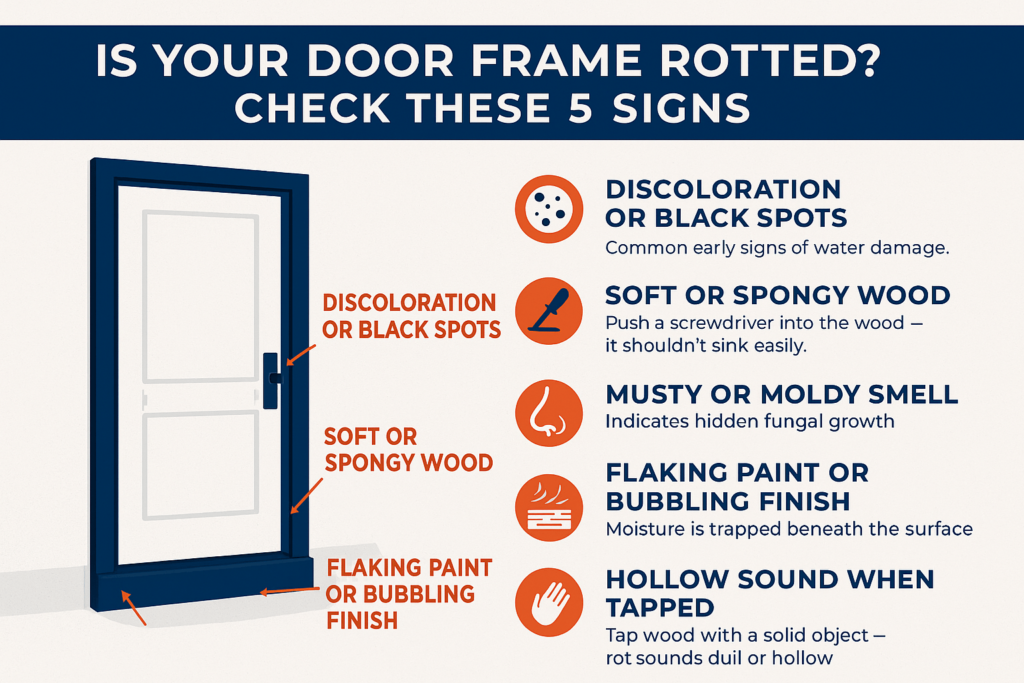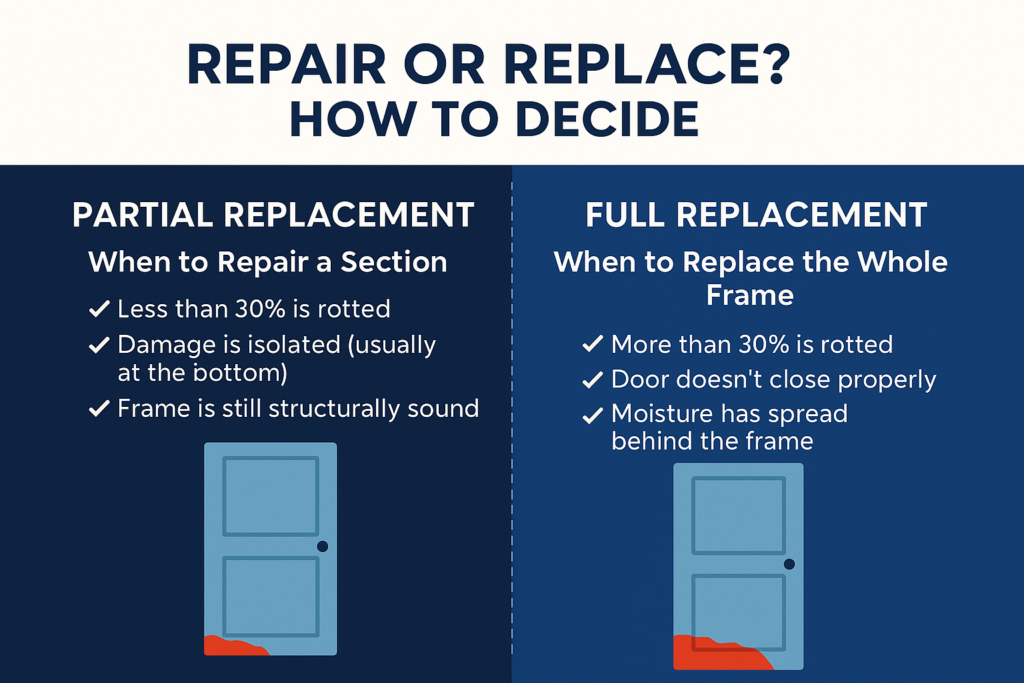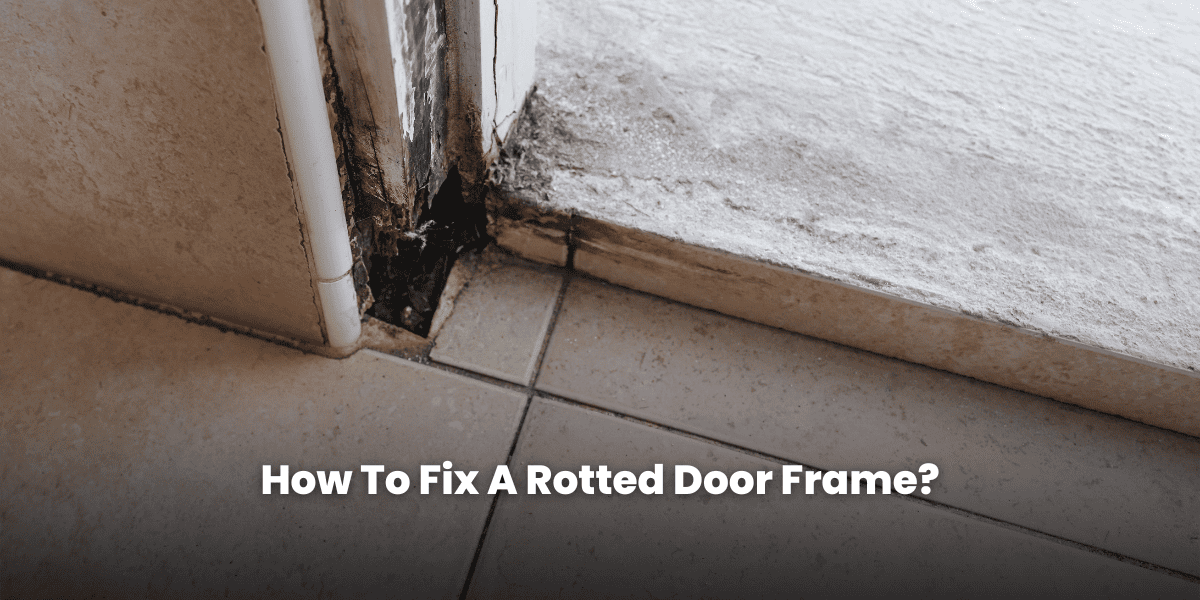Door frame rot has a way of sneaking up – what looks like a bit of wear can quickly turn into a bigger (and pricier) problem.
Whether you’re trying to figure out if it’s serious or just want to stop it from spreading, it helps to know what to look for.
We’ll break down how to spot, repair, and prevent rot step by step.
Key Notes
- Identify the extent of rot using simple tools before choosing your repair approach.
- Replace small rotted sections with wood filler; extensive damage requires complete frame replacement.
- Properly seal and prime repaired areas to prevent future moisture damage.
- Install proper flashing and drainage to keep water away from vulnerable door frames.
Assessment and Decision Making
Before starting your repair project, assess the damage thoroughly to determine whether you need a partial repair or complete replacement.

Tools and Techniques for Assessment
To properly evaluate the extent of rot in your door frame:
- Visual inspection: Look for discoloration, fungal growth, or visible deterioration
- Physical testing: Gently press suspected areas with a screwdriver – if it easily penetrates more than ¼ inch, you likely have rot
- Moisture meter: For a more precise assessment, use a moisture meter (available at hardware stores). Readings above 20% indicate conditions conducive to rot
- Tapping test: Tap the wood with a solid object; rotted areas will sound hollow compared to solid wood
Based on your assessment:
- Minimal rot (affecting less than 10% of the frame): Repair with wood fillers or epoxy
- Moderate rot (affecting 10-30% of the frame): Partial replacement may be necessary
- Severe rot (affecting more than 30% of the frame): Complete replacement is often most cost-effective
Repair Techniques for Rotted Door Frames
The extent of damage determines which repair technique will work best for your situation:

Partial Replacement Techniques
When rot is confined to specific sections of your door frame, partial replacement offers an efficient solution:
Remove the rotted section:
- Mark the area extending 3-4 inches beyond the visible rot
- Use an oscillating multi-tool to make precise cuts
- Carefully remove the damaged section without disturbing the surrounding frame
Prepare the replacement piece:
- Select pressure-treated lumber or naturally rot-resistant wood like cedar
- Cut the new piece to match the dimensions of the removed section
- Treat all sides with wood preservative before installation
Install the replacement:
- Apply waterproof wood glue to the contact surfaces
- Position the new piece and secure it with galvanized or stainless steel screws
- Fill any gaps with exterior-grade wood filler
- Sand smooth once dry
This technique works particularly well for door frames rotting at the bottom, where moisture exposure is typically highest.
Complete Replacement Techniques
For severely damaged frames, complete replacement provides a fresh start:
Remove the door and old frame:
- Remove the door from its hinges
- Use a reciprocating saw to cut through nails or screws securing the frame
- Carefully pry the frame away from the wall opening
Prepare the opening:
- Clean the rough opening, removing any debris or remaining rotted wood
- Check for and address any moisture issues in the surrounding structure
- Apply wood preservative to the rough opening
Install the new frame:
- Position the new pre-assembled frame in the opening
- Use shims to ensure it’s level and plumb
- Secure with screws through the jamb into the framing
- Apply caulk around the exterior perimeter
- Reinstall the door and test operation
Using Wood Fillers and Epoxies
For minor to moderate rot, specialized products can restore the frame without replacement:
Wood hardeners:
- Remove loose, rotted wood fibers
- Apply wood hardener according to manufacturer instructions
- Allow to dry completely (typically 1-2 hours)
Two-part epoxy fillers:
- Mix the epoxy components according to product instructions
- Apply to the damaged area, building up in layers for large voids
- Shape and mold to match the original profile
- Allow to cure fully (usually 24 hours)
- Sand and shape as needed
Water-resistant wood fillers:
- Best for smaller repairs
- Press firmly into cracks and holes
- Build up in layers for deeper repairs
- Sand smooth when dry
Product recommendations:
- Abatron WoodEpox: Excellent for structural repairs
- PC-Woody Wood Epoxy: Good moldability and adhesion
- Minwax High-Performance Wood Filler: Suitable for smaller repairs
Preventing Future Rot
Proper prevention measures after repair are essential to avoid recurring problems.
Sealing and Waterproofing Strategies
Exterior caulking:
- Apply high-quality silicone or polyurethane caulk around the entire door frame
- Pay special attention to the joint between the threshold and jamb
- Reapply caulk annually or when you notice deterioration
Paint and sealants:
- Apply primer specifically designed for exterior use
- Use high-quality exterior paint, making sure to cover all surfaces, including the bottom edges
- Consider additional clear water-repellent sealants for extra protection
Flashing installation:
- Install Z-flashing above the door to direct water away
- Consider drip caps for additional protection
- Ensure proper installation of threshold flashing
Regular Maintenance and Inspection
Implement these practices to catch problems early:
Scheduled inspections:
- Check door frames twice yearly (spring and fall)
- Look for paint cracks, discoloration, or softening wood
- Test suspicious areas with a screwdriver
Maintenance routine:
- Clean gutters regularly to prevent overflow near doors
- Maintain proper drainage away from the foundation
- Trim vegetation near doors to improve airflow
- Touch up paint or sealant as needed
Humidity control:
- Use dehumidifiers in damp areas
- Ensure proper ventilation throughout your home
- Address condensation issues promptly
Rot Spreads Fast & Weak Frames Don’t Wait
Frequently Asked Questions
How often should I inspect my door frames for rot?
Inspect door frames at least twice a year, ideally in spring and fall, and after periods of heavy rain. More frequent checks are recommended for homes in humid or rainy climates.
Can I prevent door frame rot if I live in a very humid climate?
Yes. Beyond standard prevention measures, consider installing a covered entryway, using marine-grade wood for frames, applying additional coats of sealant annually, and maintaining dehumidifiers near exterior doors.
How can I tell if the rot has spread to the wall structure behind the door frame?
Look for discoloration on adjacent walls, soft spots extending beyond the frame, musty odors, or visible mold. If you can easily push a screwdriver through the wall near the frame, structural damage may have occurred and professional assessment is recommended.
Is it worth repairing a rotted door frame, or should I just replace the entire door unit?
For localized rot affecting less than 30% of the frame, repairs are cost-effective. If rot has spread extensively, affects multiple areas, or has compromised the door’s functionality, complete replacement often provides better long-term value.
What’s the best time of year to repair or replace a rotted door frame?
Aim for dry periods with moderate temperatures (50-80°F). Late spring and early fall typically offer ideal conditions for proper curing of fillers, adhesives, and finishes.
Conclusion
Rot in a door frame can start small, but left alone, it spreads fast and weakens the whole structure.
Whether you’re dealing with minor damage or your frame’s beyond saving, the fix depends on catching the issue early and using the right materials. From wood fillers to full-frame replacements, there’s a solid repair approach for every level of damage.
If you’re unsure what your door needs, book a free consultation and we’ll talk through the best fix for your space and budget – no strings attached.



